Cliff Diving in Aruba: A Comprehensive Guide
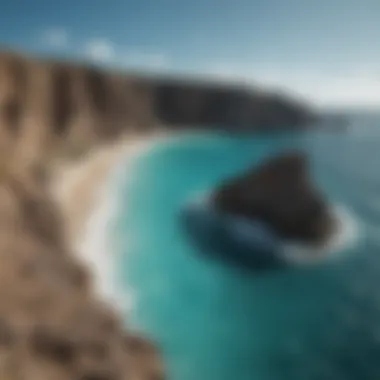
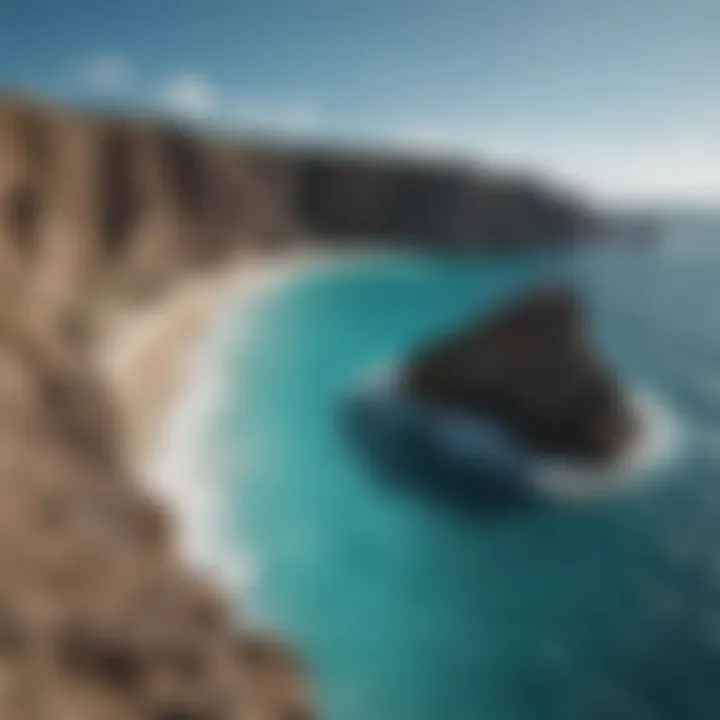
Intro
Cliff diving in Aruba is not just an adrenaline rush; it also reveals the island's rich cultural fabric and stunning natural beauty. Known for its crystal-clear waters and picturesque cliffs, Aruba has become a haven for thrill seekers and adventure lovers. The sport attracts novices and seasoned divers alike, offering a unique combination of excitement and breathtaking views. This exploration will guide you through the essential techniques, safety measures, gear, and cultural significance of cliff diving in Aruba, providing a comprehensive understanding of what makes this activity so captivating.
Techniques and Tips
Skill Development
Cliff diving requires a combination of physical prowess and mental focus. For beginners, it's essential to cultivate foundational skills like strong swimming abilities and body control. Start by practicing jump techniques in safe environments, gradually moving to higher elevations as confidence builds. Engaging with experienced divers can greatly enhance your learning process, as they can impart crucial insights into form and technique.
Practical Techniques
When diving off cliffs, the entry into the water is paramount. Divers must ensure they enter feet first to minimize water resistance and avoid injury. A proper hand position and body alignment also play a crucial role in successful dives. It's helpful to familiarize oneself with various dive techniques, such as tuck jumps or straight dives.
Common Mistakes to Avoid
- Avoid jumping directly into the water without assessing your surroundings.
- Ensure you have the correct body posture during the dive to prevent injuries.
- Don’t forget to judge the depth of the water below; shallow waters can be hazardous.
Gear and Equipment
Essential Gear for Beginners
Before diving into cliff diving, suitable gear is essential. For beginners, a well-fitted swimsuit, water shoes, and rash guards can enhance comfort and safety. A personal flotation device (PFD) is recommended, especially for those who are still mastering their skills in the water.
Latest Innovations and Trends
The sport of cliff diving is continuously evolving, with new gear and technology enhancing the experience. Advances in swimwear materials, impact-resistant accessories, and waterproof cameras have made the sport safer and more enjoyable. Worth noting is the popularity of drone photography, which captures exhilarating dives from an aerial perspective, making it an exciting trend for both divers and onlookers.
Reviews and Comparisons
It's beneficial to research gear before making a purchase. Resources like Reddit and Facebook groups provide valuable insights and first-hand reviews. Engaging with these communities can help divers choose the best equipment suited to their needs.
Safety Measures
Essential Safety Gear
Safety should always be the primary concern in cliff diving. Essential gear includes helmets and padded suits, which minimize the risk of injury upon impact with water. Athletes should also consider wearing buoyancy aids until they feel confident in their abilities.
Best Practices for Safe Participation
Diving spots should always be scouted beforehand. Check for obstacles in the water, such as rocks or coral. Additionally, it’s advisable to dive with a buddy, ensuring that help is available in case of emergencies.
Injury Prevention and Management
Common injuries in cliff diving result from improper technique or equipment failure. It's crucial to keep a first-aid kit readily accessible during events. Learning basic injury management techniques can aid in addressing problems before help arrives.
"Always prioritize safety first. Diving should be exhilarating, not dangerous."
Spotlights on Extreme Sports
Featured Sport of the Month
Cliff diving is often featured in extreme sports showcases for its breathtaking visuals and intense thrill. Each publication highlights the sport's evolution and the unique environments where it is practiced, such as Aruba’s captivating coastline.
Profiles of Prominent Athletes
Several athletes have made a name for themselves in the realm of cliff diving. Profiles of prominent divers often reveal their training regimens and the challenges they have faced. Learning from these athletes’ experiences can provide valuable lessons for both novice and advanced divers.
Prologue to Cliff Diving in Aruba
Cliff diving is more than just an extreme sport; it embodies the spirit of adventure and exploration. This article sheds light on the unique experiences that cliff diving in Aruba offers. The stunning coastline and varied geological formations present a perfect backdrop for both novice and seasoned divers.
Historical Overview
The tradition of diving off cliffs in Aruba has roots that trace back several decades. Initially, it emerged as a local recreational activity, intertwined with cultural events and community gatherings. Over the years, it evolved into a competitive sport, attracting divers from around the world. Historical records indicate that climbers engaged in this thrill-seeking pastime for both the adrenaline rush and the sense of achievement it provides. The sport's popularity grew alongside Aruba's tourism, which spotlighted its breathtaking natural environments.
As more divers ventured to experience the scenic beauty, it became clear that this was no ordinary sport. The cliffs of Aruba are not only physical challenges but also cultural landmarks that tell stories of the island. The locals celebrate their heritage by engaging in cliff diving, often passing down techniques and secrets to the next generation.
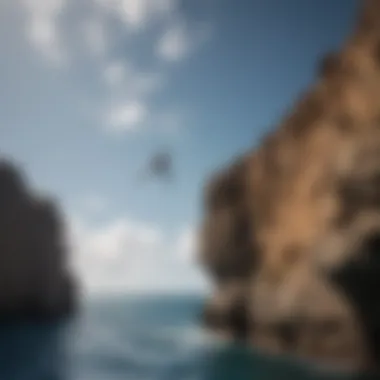
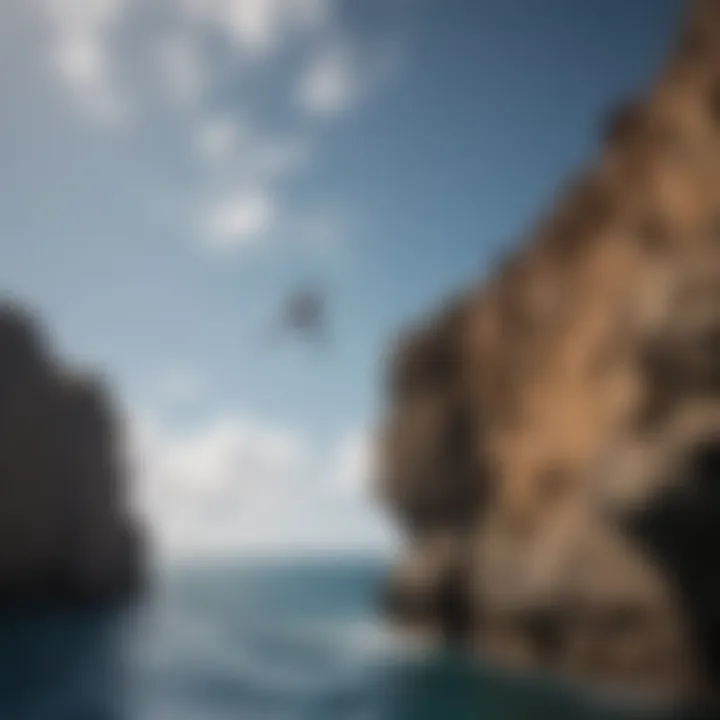
The Allure of Aruba
Aruba's geography is a key factor in its appeal to cliff diving enthusiasts. The island is known for its pristine waters, dramatic cliffs, and tranquil beaches. Each location offers a distinct diving experience that caters to every level of diver.
The warm Caribbean waters boast visibility that enhances the diving experience. The natural beauty of the surroundings makes every dive an aesthetic pleasure. From the vibrant marine life to the azure depths, every dive can feel magical.
Diving here also provides the thrill of varying heights and landscapes. For example, Casibari Rock offers a mix of sheer drops and accessible ledges. In contrast, Frenchman’s Pass and Weeping Woman's Rock provide more diverse challenges. This variety ensures that the experience is dynamic, enticing divers to push their limits and test their skills.
The combination of challenge and beauty is outstanding. Cliff diving in Aruba is about embracing nature while conquering fears.
Moreover, the warmth of Aruban hospitality creates a community of divers. This welcoming atmosphere nurtures both competition and camaraderie among participants. Overall, cliff diving becomes more than just a sport; it fosters connections and memories that last a lifetime.
Cliff Diving Locations in Aruba
Understanding the cliff diving locations in Aruba is essential for both novice and experienced divers. These locations offer varying elevations, unique challenges, and stunning landscapes that enhance the diving experience. Each spot possesses its characteristics, making it vital to choose according to one’s skill level and preferences. Moreover, the accessibility and logistical considerations of each diving location play a significant role in the overall feasibility of engaging in this sport.
Top Diving Spots
Casibari Rock
Casibari Rock stands out as a popular cliff diving location for several reasons. This site boasts a moderate height of approximately 35 feet, catering to divers looking to test their skills without facing an overly intimidating jump. The rock has a stable pathway leading to the diving point, making it relatively easy to access for many enthusiasts. One of Casibari’s unique features is its base, which is shallow but allows divers to land safely with the right technique.
While it is suitable for beginners, advanced divers can also enjoy the thrill by performing more complex dives. However, caution is necessary, as the shallow waters may pose risks if dives are not calculated properly. Hence, Casibari Rock combines accessibility with a straightforward diving experience that appeals to various skill levels.
Frenchman’s Pass
Frenchman’s Pass offers an entirely different flavor of diving with its dramatic cliffs rising about 40 feet high. This location is frequented by those seeking a more exhilarating experience. The key characteristic of Frenchman’s Pass is its natural beauty, providing divers with breathtaking views of the turquoise sea during their jumps. Unlike other spots, the approach to the dive point may require some climbing, which adds to the adventure but can also be a challenge for beginners.
The unique feature of this location is the cave-like formations around the base, which can enhance the visual aspects for divers and spectators alike. Frenchman’s Pass may have less forgiving waters than Casibari, making it more suitable for those with diving experience. This intensified thrill, coupled with the scenic backdrop, makes it a favored choice among experienced cliff divers seeking the ultimate rush.
Weeping Woman's Rock
Weeping Woman's Rock is another notable site that holds historical and cultural significance in Aruba. With a height of roughly 30 feet, this location offers a balancing act for those who appreciate both story and sport. The rock is named after a local legend, adding intrigue to the diving experience. The key characteristic that sets Weeping Woman's Rock apart is its expansive view of the surroundings, making it ideal for those wishing to capture stunning photographs post-dive.
Its landing area is relatively deep, which provides increased safety for divers. This makes it an attractive spot for less experienced individuals who may be apprehensive about jumping from higher cliffs. The combination of depth and photographable scenery helps make Weeping Woman's Rock a beneficial choice for divers of various skillsets. Overall, its unique characteristics resonate well with those enthusiastic for both the sport and the local tales surrounding it.
Accessibility and Logistics
Accessibility is a key consideration for anyone planning to engage in cliff diving in Aruba. Many of the prime locations, including Casibari Rock, Frenchman’s Pass, and Weeping Woman's Rock, are relatively close to main roads, making them easy to reach by car or taxi. Local guides are frequently available to assist newcomers, ensuring safety and enhancing the experience.
Logistics can entail parking availability, entry paths, and any necessary permits or fees. It is essential to assess whether facilities such as restrooms or shaded areas are present, especially for divers planning to spend significant time at these locations. The combination of convenience and the availability of resources enhances the overall enjoyment and safety during the diving experience.
Techniques for Safe Cliff Diving
Cliff diving is not just an extreme sport; it requires a respectful understanding of diving techniques to ensure safety and enjoyment. Mastering the basic techniques can significantly enhance the experience for both novice and experienced divers. Proper techniques mitigate the risk of injuries and help divers make a smooth entry into the water.
Understanding the Dive
To dive safely, one must understand the mechanics involved. Cliff diving is about more than just jumping off a height. Key elements include positioning, body control, and water entry.
- Body Positioning:
A correct posture is essential during the dive. Divers should keep their bodies straight, maintaining a streamlined shape to cut through the water effectively. This reduces resistance and promotes smoother entries. - Breath Control:
Many divers overlook the importance of managing their breath before diving. Holding the breath until submersion can prevent water from entering the lungs and help maintain focus during the dive process. - Timing the Jump:
Timing dramatically impacts safety. A dive must be timed with the appropriate wave cycles to avoid turbulent water. An ill-timed jump can lead to dangerous situations.
Optimal Entry Angles
Understanding entry angles is pivotal in cliff diving. The angle at which a diver enters the water determines the overall experience and safety.
- Ideal Angle:
For most cliff diving scenarios, an entry angle of approximately 45 degrees is ideal. This angle minimizes splash and helps in slicing through the water efficiently. - Adjusting for Height:
As the height increases, divers may need to adjust their angles. From lower heights, a steeper angle can be effective, while from higher elevations, a more gradual angle is often necessary to reduce the impact. - Practicing Techniques:
Divers should practice from various heights to gain a better sense of the appropriate angle. Utilizing platforms or lower cliffs for practice can improve confidence and techniques before attempting higher jumps.
"Diving is not merely an act of jumping; it's a careful choreography with nature. Understanding techniques is vital for a safe experience."
By focusing on these techniques, divers can enhance their skills while prioritizing safety. This understanding not only fosters individual confidence but also contributes to a safer environment for all participants. Thus, delving deeper into techniques can benefit both the adventure seeker and the broader diving community.
Safety Considerations
Engaging in cliff diving, particularly in a popular destination like Aruba, calls for a robust focus on safety. Underestimating risks can lead to serious injuries, so understanding and implementing safety measures is essential. This aspect ensures that the thrill does not become a tragedy. The benefits of incorporating safety considerations include fostering a culture of responsibility, enhancing the diving experience, and promoting the sport effectively.
Assessing Risks
Before taking the plunge, assessing risks is a critical step. Every dive and location has unique factors that can affect safety. Key elements to examine include:
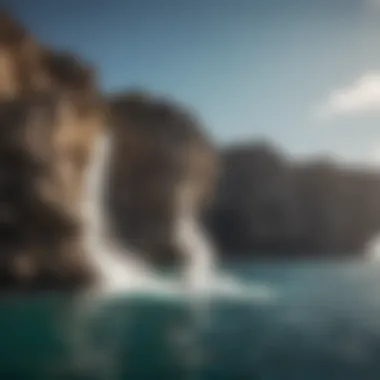
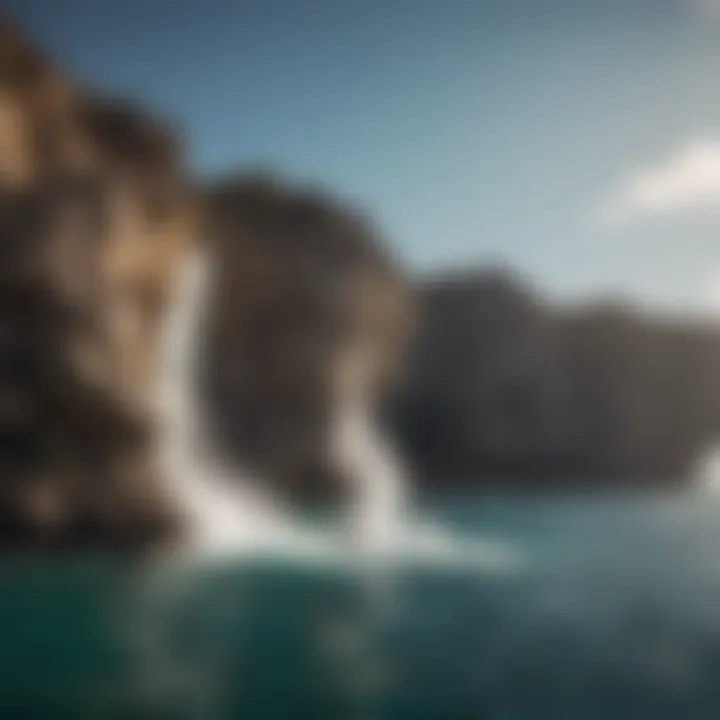
- Height of the Cliff: Higher cliffs increase the risk of injury. Divers need to be aware of the actual height they are jumping from and its associated dangers.
- Water Depth: Not all cliff jumping spots have sufficient water depth to cushion the dive safely. Checking local guidelines can prevent severe accidents.
- Underwater Hazards: Searching the water for rocks, coral, or other obstructions is important. Unseen dangers can lead to serious injury upon entry.
- Weather Conditions: Wind and waves in Aruba can change swiftly. Evaluating weather forecasts ensures safer diving conditions.
Making informed decisions based on these assessments can drastically lower the chance of accidents.
Emergency Response Guidelines
Even in the best-prepared situations, emergencies can occur. Therefore, having an emergency response plan is paramount. This can mean the difference between a quick resolve and grave consequences. Key components of an effective plan include:
- Establishing Communication: Divers should ensure they and their group have a way to communicate in case of an emergency. This might include having a cell phone or radio ready.
- Identifying Rescue Services: Familiarizing with local emergency services can provide quick assistance in case of injury.
- First Aid Knowledge: Basic first aid skills can help stabilize an injured person until professional medical help arrives. Knowing how to handle common injuries related to diving is invaluable.
- Swimming Proficiency: All divers should have strong swimming skills, as currents can swiftly separate a diver from the jumping point.
"In cliff diving, preparation doesn’t just prevent accidents; it promotes an environment where divers can truly enjoy their passion."
Incorporating thorough safety considerations and emergency plans will ensure that cliff diving in Aruba remains a thrilling yet secure adventure for all enthusiasts.
Equipment for Cliff Diving
The right equipment is vital for anyone aspiring to engage in cliff diving, especially in a diverse environment such as Aruba. Here, the blend of adventure and safety hinges greatly on the choices made concerning gear. Without proper equipment, the risk associated with this extreme sport may escalate significantly. A thorough understanding of what to wear can enhance performance and minimize potential injuries. The focus will be on two primary categories: essential gear and their maintenance, which are indispensable for both novice and experienced divers.
Essential Gear
Suits and Footwear
Suits and footwear play a crucial role in protecting the diver. Wetsuits, for instance, are designed to insulate and also shield from sharp rocks or marine creatures. The thickness of the wetsuit contributes to buoyancy and warmth, which is essential when diving into cooler waters. A popular choice among divers is the shorty wetsuit, as it offers flexibility and comfort.
Footwear, specifically water shoes, is equally important. These shoes provide traction and protection. Notably, they prevent slips on wet surfaces, which can occur frequently during the approach to the diving spot. A key characteristic of good water shoes is their lightweight design, which does not hinder movement while diving.
The unique feature of footwear in cliff diving is the grip they provide. A strong rubber sole can assist divers in maintaining stability on rocky surfaces. However, the disadvantage could be their bulkiness, which might be uncomfortable for some divers.
Protective Equipment
Protective equipment is essential in ensuring safety during a dive. Helmets and padded vests are popular among cliff divers, as they provide an additional layer of protection during falls or impacts. These items guard against head injuries and bruises that can occur upon entry into the water.
A key characteristic of protective equipment is its lightweight nature. This feature allows for ease of movement while diving, which is critical for maintaining technique and form. The unique aspect here is the shock absorption ability of these protective items, helping to lessen the impact during landing.
However, protective equipment may carry some disadvantages. They can be uncomfortable to wear for extended periods, and some divers may feel restricted in their movements.
Equipment Maintenance
Proper maintenance of diving equipment ensures longevity and safety. Wetsuits should be washed with fresh water after each use to remove salt and sand. This practice helps to prevent deterioration of the material. Likewise, water shoes need to be cleaned regularly and dried properly to avoid mold and bad odors.
For protective gear, inspecting for any signs of wear and tear is crucial. Helmets must be checked for cracks, and padded vests should be examined for any damage that could reduce their effectiveness. Keeping equipment in good condition contributes to a more enjoyable and safer diving experience.
Safety is just as important as thrill; the right equipment makes all the difference in cliff diving.
By understanding the essential gear and emphasizing equipment maintenance, cliff divers can ensure their experiences in Aruba are both exciting and safe. Proper preparation in terms of equipment contributes greatly to the overall joy of the sport.
Training and Preparation
Training and preparation are essential components for anyone interested in cliff diving, especially in a location like Aruba. The unique environmental conditions and varying heights of cliffs require divers to take a methodical approach toward skill development and safety. Engaging in actual practice not only boosts confidence but also enhances performance. Moreover, adequate training allows for a smoother transition from novice to experienced diver, reducing the potential for accidents.
Finding Qualified Instructors
Finding qualified instructors should be a priority for those looking to get into cliff diving. These instructors offer valuable insight into the techniques and safety measures that are critical for successful diving. A good instructor will assess your current skill level and craft a tailored training plan that suits your specific needs. They usually have a deeper understanding of the local diving spots, including hidden risks that might not be apparent to beginners. Look for instructors with recognized certifications and positive reviews. This ensures you receive quality training in cliff diving safety, proper form, and entry techniques. Websites, such as reddit.com and facebook.com, often contain valuable community forums where you can find recommendations and perhaps even meet fellow divers for practice or mentorship.
Progression from Beginner to Expert
The progression from beginner to expert in cliff diving requires dedication and a clear training strategy. Beginners should start with dives from lower heights, gradually increasing as they gain confidence and skill. Consider the following steps for progression:
- Master the Basics: Start with a focus on basic dive techniques, ensuring you have a solid understanding of body positioning during the dive and entry into the water.
- Regular Practice: Make it a point to practice consistently. Repetition solidifies skills and builds muscle memory, which is essential for performing well under pressure.
- Learn Advanced Techniques: Once comfortable, shift focus toward advanced techniques such as flips, twists, and varying entry angles.
- Feedback and Adjustment: Seek regular feedback from instructors or peers. They can provide tips on what to improve, thus enhancing your progression.
- Dive with Experienced Peers: Connecting with seasoned divers can offer insights that are not found in formal training. Observing their techniques and asking for advice provides practical learning opportunities.
Regularly challenging yourself helps to overcome mental barriers and boosts overall confidence in skills.
Cultural Significance of Cliff Diving in Aruba
Cliff diving in Aruba represents not just an extreme sport; it embodies the rich cultural tapestry interwoven throughout the island. This activity connects locals and visitors alike, fostering a sense of community and shared passion for the natural beauty of Aruba. Cliff diving transcends mere entertainment; it serves as a form of expression, a celebration of physical prowess, and a powerful symbol of unity. For many locals, it is a tradition that has been passed down through generations, thus enhancing its cultural value.
Community Involvement
Community participation plays a crucial role in the cliff diving scene of Aruba. Local divers share their skills and experiences, creating an inclusive environment for enthusiasts. This involvement often takes place at various locations across the island where cliff diving is popular. The sense of camaraderie among divers is palpable, as they gather to cheer each other on, exchange tips, and celebrate achievements.
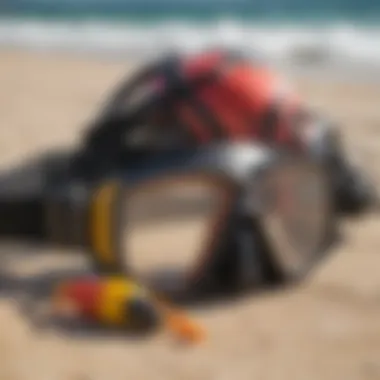
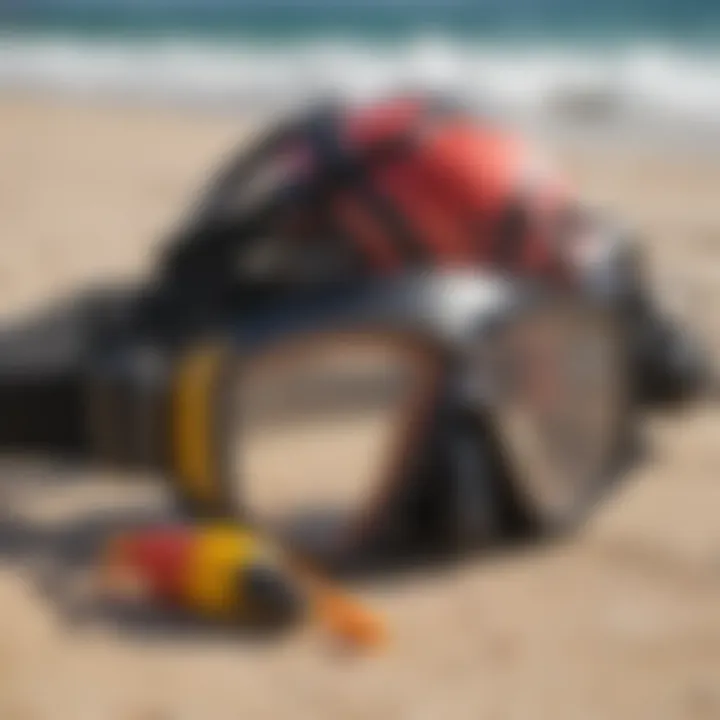
Local organizations also work diligently to promote safe diving practices and preserve the natural spots. Youth programs are frequently organized, allowing younger generations to learn the sport under the guidance of experienced divers. These initiatives foster respect for both the sport and the environment, promoting sustainable practices and encouraging responsible diving.
Cliff Diving Festivals and Events
Aruba hosts a variety of events dedicated to the celebration of cliff diving. These festivals not only showcase incredible diving talent but also highlight Aruba’s vibrant culture. During such events, professional divers from around the world are invited, creating a platform for international competition.
Such events feature:
- Live music performances
- Local food and drink vendors
- Cliff diving exhibitions
- Workshops for newcomers
"Cliff diving festivals are not just about the dives; they are about bringing the community together and sharing the love for this incredible sport."
In addition, these gatherings foster tourism, drawing thrill-seekers and adventure lovers to the island, thus supporting local businesses and enhancing Aruba’s economy. The unity felt during these events reinforces the cultural significance of cliff diving within the broader context of Aruban life.
Environmental Considerations
In the realm of cliff diving, the surrounding environment plays a crucial role in both the experience and the sustainability of the sport. In Aruba, the natural landscape and its ecosystems can be significantly affected by human activity. Understanding these environmental considerations is essential for fostering a sustainable approach to cliff diving. This section will discuss how cliff diving impacts local ecosystems and the various conservation efforts that can help mitigate these effects.
Impact on Local Ecosystems
Cliff diving, while exhilarating, has consequences that extend beyond the thrill-seekers. First, the physical presence of divers can disturb marine life. Jumping from cliffs can create ripples in the water, potentially disrupting fish habitats and spawning grounds. Moreover, areas frequented by divers may suffer from increased litter and human waste, which can lead to pollution. The effect on coral reefs nearby is also notable. Coral is highly sensitive to changes in its environment. The influx of people may lead to damage through anchoring, trampling, and water pollution. To maintain the health of these ecosystems, it is vital to recognize and address these issues before they escalate.
In addition, sound pollution from divers and boat traffic can stress local wildlife, noticeably affecting communication among endangered species. The need for a balanced approach to recreational activities is clear.
Conservation Efforts
To offset the potential negative impacts of cliff diving, numerous conservation efforts are underway in Aruba. These initiatives aim to protect the island's diverse ecosystems while promoting sustainable tourism practices. Educating divers on the importance of preserving natural habitats is a priority. For example, awareness campaigns stressing the significance of not disturbing wildlife and adhering to proper waste disposal practices can create a collective responsibility among visitors.
Additionally, local organizations and governmental bodies are establishing regulations surrounding cliff diving spots. These rules may involve designating specific areas for diving that are less sensitive ecologically. Furthermore, encouraging partnerships between divers and environmental groups leads to joint efforts in cleanup drives and conservation projects.
The community’s involvement is vital. Schools and local NGOs are working together to teach the younger generation about the marine ecosystem's fragility and the importance of its protection. By instilling the values of environmental stewardship at an early age, a culture of respect and care for the natural world can be fostered.
By implementing these conservation strategies, Aruba can ensure that cliff diving remains a thrilling experience for generations to come, while simultaneously preserving the rich biodiversity that makes the island unique.
Future of Cliff Diving in Aruba
As cliff diving continues to draw attention globally, its future in Aruba is a subject of interest and significance. The island stands at a crossroads where the beauty of the natural environment meets the thrill of extreme sports. The rise in popularity of this activity presents various opportunities and considerations for divers, local communities, and tourism.
Trends in the Sport
Recent trends in cliff diving indicate a shift towards more inclusive practices and safety enhancements. Professional diving events have become more frequent, showcasing talent from around the world and elevating the island's profile as a premier location for diving enthusiasts.
- Increased Uniqueness: Divers are not just performing standard dives; they are exploring unique and creative jump styles, blending acrobatic movements with breathtaking scenery.
- Community Engagement: More local and international competitions promote community involvement, encouraging aspiring divers to participate.
- Diversified Skill Levels: With the rise in diversification, more beginner-friendly dives and workshops are being organized, thus making the sport more accessible to newcomers.
This fusion of tradition and innovation ensures that the sport remains dynamic and engaging for all participants.
Technological Advancements
Technological advancements are playing a critical role in shaping the future of cliff diving in Aruba. These innovations not only enhance the athlete's experience but also prioritize safety and environmental considerations.
- Safety Gear: Improved safety equipment, such as specialized helmets and flotation devices, now provide better protection for divers while they navigate their jumps.
- Digital Training Tools: Applications and online platforms allow divers to improve their skills through virtual coaching and analysis of diving techniques.
- Environmental Monitoring: Technology is also enabling better assessment and monitoring of dive locations, ensuring preservation of their natural beauty while assessing safety risks related to ecological impacts.
Integration of these advancements in cliff diving has the potential to enrich the diving experience, making it safer and more enjoyable for participants.
The evolving landscape of cliff diving in Aruba signals not only growth in athleticism but also a commitment to sustainability and community integration.
In summary, the future of cliff diving in Aruba appears bright. As trends shift toward inclusiveness and innovation, the island's global standing is poised for enhancement. Emphasizing safety through technology and community involvement ensures its legacy as a thrilling sport continues for generations to come.
Ending
The conclusion of this article synthesizes critical insights regarding cliff diving in Aruba. Cliff diving is not merely a sport; it thrives as an integral part of Aruba's cultural and environmental landscape. Besides adrenaline, it embodies a deep connection with nature and community. As many thrill-seekers and adventure enthusiasts seek unique experiences, understanding the multifaceted elements involved in cliff diving is crucial. The key takeaway is that preparation is essential to enjoy this extreme sport safely and responsibly. Above all, participants should appreciate the natural beauty of the surroundings while respecting local ecosystems.
Summary of Key Insights
Throughout this article, we explored various elements that define cliff diving in Aruba. Here are key points:
- Locations: The island boasts stunning cliff diving spots like Casibari Rock and Frenchman’s Pass.
- Techniques: Proper diving techniques and angles promote safer entries and mindful enjoyment.
- Safety: Understanding risks and having emergency response guidelines ensures safety for all divers.
- Cultural Impact: Cliff diving represents community pride, especially through various events and festivals celebrating this sport.
These insights highlight not only the thrill of cliff diving but also its cultural significance and responsibility towards nature.
Encouragement for Participation
For those intrigued by cliff diving, there are several reasons to take the plunge. This sport offers a unique way to experience the breathtaking views of Aruba while engaging with a vibrant community. Newcomers should begin with training under qualified instructors to ensure safe and enjoyable diving experiences. Your first leap could open doors to new friendships and unforgettable adventures.
Finally, whether you dive to conquer fears or simply to experience the island's beauty, consider participating in the local cliff diving culture. It is an opportunity to embrace adventure and learn more about Aruba’s natural wonders. So gear up, explore the diverse locations, and dive into this thrilling sport!







